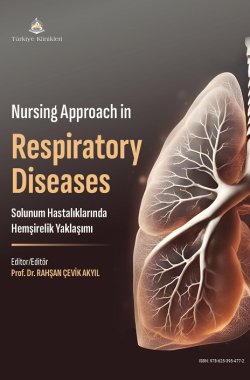Necessary Oxygen Treatments in Respiratory Support
Yağmur AKBALa , Vacide AŞIK ÖZDEMİRa , Nesrin NURALb
aRecep Tayyip Erdogan University Faculty of Health Sciences, Department of Nursing, Department of Internal Medicine Nursing, Rize, Türkiye
bKaradeniz Technical University Faculty of Health Sciences, Department of Nursing, Department of Internal Medicine Nursing, Trabzon, Türkiye
Akbal Y, Aşık Özdemir V, Nural N. Necessary oxygen treatments in respiratory support. In: Çevik Akyıl R, ed. Nursing Approach in Respiratory Diseases. 1st ed. Ankara: Türkiye Klinikleri; 2025. p.68-72.
ABSTRACT
The aim of respiratory support is to provide adequate ventilation and oxygenation. Oxygen therapy, one of the most commonly used treatment modalities in respiratory failure caused by the deterioration of this condition, is performed with different methods and for different durations. There are critical points in oxygen therapy initiation, maintenance, and follow-up. Among the points to be considered, inspiratory and expiratory monitoring are especially effective in guiding the process. During the oxygen therapy process, monitoring the patient’s vital signs significantly shapes the course of treatment. Increasing evidence-based studies to follow current guidelines on this subject will reduce the risk of complications that may develop and improve the quality of care.
Keywords: Nursing care; oxygen inhalation therapy; respiratory insufficiency
Kaynak Göster
Referanslar
- Pisani I, Comellini V, Nava S. Noninvasive ventilation versus oxygen therapy for the treatment of acute respiratory failure. Expert Review of Respiratory Medicine. 2016;10(7):813-21. [Crossref] [PubMed]
- Özyılmaz E. Respiratory failure. Cukurova Medical Journal. 2014;39(3):428-42. [Crossref]
- Blakeman TC. Evidence for oxygen use in the hospitalized patient: Is more really the enemy of good?. Respiratory Care. 2013;58(10):1679-93. [Crossref] [PubMed]
- Girardis M, Busani S, Damiani E, Donati A, Rinaldi L, Marudi A, et al. Effect of conservative vs conventional oxygen therapy on mortality among patients in an intensive care unit: The oxygen-ICU randomized clinical trial. Jama. 2016;316(15):1583-9. [Crossref] [PubMed]
- Börekci Ş, Umut S. Oxygen therapy. Turkish Thoracic Society Respiratory Devices guide. 2011. p.12-8.
- Scala R. Challenges on non-invasive ventilation to treat acute respiratory failure in the elderly. BMC pulmonary Medicine. 2016;16(1): 1-10. [Crossref] [PubMed] [PMC]
- Hale KE, gavin C, O'Driscoll BR. Audit of oxygen use in emergency ambulances and in a hospital emergency department. Emergency Medicine Journal. 2008;25(11):773-6. [Crossref] [PubMed]
- Siemieniuk RA, Chu DK, Kim LHY, güell-Rous MR, Alhazzani w, Soccal pM, et al. Oxygen therapy for acutely ill medical patients: A clinical practice guideline. 2018;363:1-10. [Crossref] [PubMed]
- Allardet-Servent J, Sicard g, Metz V, Chiche L. Benefits and risks of oxygen therapy during acute medical illness: just a matter of dose! La Revue De Médecine Interne. 2019;40(10):670-6. [Crossref] [PubMed]
- Ersoy EO, Topeli A. Oxygen Therapy Systems in Respiratory Failure. Turkish Journal of Medical & Surgical Intensive Care Medicine. 2016;7(3):99-105. [Crossref]
- Pickard K. Long-Term oxygen therapy. Innovait. 2015;8(8):455-61. [Crossref]
- Uysal H. Oxygen therapy and nursing care.Turk Soc Cardiol Turkish Journal of Cardiovascular Nursing. 2010;25(1):40-4. [Crossref]
- Mittal K, Jain A, Bansal T, Kumar p, Mittal A. Oxygen therapy. Journal of pediatric Critical Care. 2018;5(4):60-8. [Crossref]
- O'driscoll BR, Howard LS, Earis J, Mak V. BTS guideline for oxygen use in adults in healthcare and emergency settings. Thorax. 2017;72(1):1-90. [Crossref] [PubMed]
- Whittle JS, pavlov I, Sacchetti AD, Atwood C, Rosenberg MS. Respiratory support for adult patients with COVID‐19. Journal of The American College of Emergency physicians Open. 2020;1(2):95-101. [Crossref] [PubMed] [PMC]
- Batool S, garg R. Appropriate use of oxygen delivery devices. The Open Anesthesia Journal. 2017;11(1):35-38. [Crossref]
- Hui DSC, Chan MTV, Chow B. Aerosol dispersion during various respiratory therapies: A risk assessment model of nosocomial infection to healthcare workers. Hong Kong Med J. 2014;20(4):9-13.
- Küçükakgün H, Enç N. Oxygen therapy and nursing care safe oxygen administration. Journal of Intensive Care Nursing. 2021;25(1):10-22.
- Bhalla AK, Newth CJ, Khemani Rg. Respiratory support in children. paediatrics and Child Health. 2019;29(5):210-7. [Crossref]
- Renda T, Corrado A, Iskandar g, pelaia g, Abdalla K, Navalesi p. High-flow nasal oxygen therapy in intensive care and anaesthesia. British Journal of Anaesthesia. 2018;120(1):18-27. [Crossref] [PubMed]
- Ciftci F. High Flow Oxygen Systems. Current Chest Diseases Series. 2018;6(2):171-6. [Crossref]
- Todur pM, Chaudhuri S, Eeshwar MV, Teckchandani D, Venkateswaran R. Oxygen sources and delivery devices: essentials during COVID-19. Indian Journal of Respiratory Care. 2021;10(2):171-1. [Crossref]
- Hardavella g, Karampinis I, Frille A, Sreter K, Rousalova I. Oxygen devices and delivery systems. Breathe. 2019;15(3):108-6. [Crossref] [PubMed] [PMC]
- Nishimura M. High-Flow nasal cannula oxygen therapy devices. Respiratory Care. 2019;64(6):735-42. [Crossref] [PubMed]
- Gaikwad S, waghmare S, Rathod S, Juvekar S, Nalavade S. Oxygen devices for long-term oxygen therapy and comparison for use in low-resource settings. International Research Journal of Engineering and Technology. 2021;8(4):3349-54.
- Dakkak J, Tang w, Smith JT, Balasubramanian A, Mattson M, Ainechi A, et al. Burden and unmet needs with portable oxygen in patients on long-term oxygen therapy. Annals of the American Thoracic Society. 2021;18(9):1498-505. [Crossref] [PubMed]
- Alises SM, Caneiras C, Díaz-Lobato S. A telephone-based survey of current trends, habits and beliefs in patients receiving portable oxygen therapy in madrid, Spain. ERJ Open Research. 2019;5(2):2-9. [Crossref] [PubMed] [PMC]
- Jacobs SS, Lindell KO, Collins Eg, garvey CM, Hernandez C, Mclaughlin S, et al. patient perceptions of the adequacy of supplemental oxygen therapy. results of the american thoracic society nursing assembly oxygen working group survey. Annals of the American Thoracic Society. 2018;15(1):24-32. [Crossref] [PubMed]
- Zorlu D. Is the use of home-type respiratory support devices effective?. J DEU Med. 2021;35(2):201-17.

